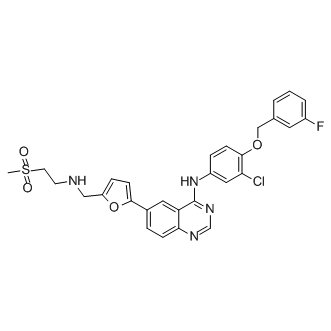| In Vivo: |
Lapatinib (GW2016) is potent at inhibiting the growth of BT474 and HN5 human tumor xenografts. A dose-responsive inhibition of both models occurred on treatment of tumor-bearing mice with 30 and 100 mg/kg Lapatinib orally, twice daily. Complete inhibition of tumor growth is seen at the 100 mg/kg dose. At this dose, there is <10% weight loss in treated animals over the course of the 21-day treatment. Lapatinib treatment inhibits tumor xenograft growth of the HN5 and BT474 cells in a dose-responsive manner at 30 and 100 mg/kg orally, twice daily, with complete inhibition of tumor growth at the higher dose[1]. Lapatinib (100 mg/kg/day, oral gavage) induces severe oxidative damage in the cardiac tissue of rat[3]. |
| In Vitro: |
The IC50 of Lapatinib (GW2016) values for inhibition of enzyme activity are generated by measuring inhibition of phosphorylation of a peptide substrate. With the exception of ErbB-4 (IC50, 367 nM), Lapatinib is >300-fold selective for EGFR and ErbB-2 over other kinases tested[1]. IC50 values of Lapatinib (GW2016) for BT474, SKBR3, EFM192A, HCC1954, MDAMB453 and MDAMB231 cells is 36±15.1 nM, 80±17.3 nM, 193±66.5 nM, 416.6±180 nM, 6.08±0.825 μM and 7.46±0.102 μM, respectively. Treatment with Lapatinib results in IC50 values of ≤ 0.16 μM on the EGFR- and the ErbB-2-overexpressing tumor cell lines[2]. |






















